Deck 22: Capital Structure Patterns in the United States
Question
Question
Question
Question
Question
Question
Question
Question
Question
Question
Question
Question
Question
Question
Question
Question
Question
Question
Question
Question
Question
Question
Question
Question
Question
Question
Question
Question
Question
Question
Question
Question
Question
Question
Question
Question
Question
Question
Question
Question
Question
Question
Question
Question
Question
Question
Question
Question
Question
Question
Question
Question
Question
Question
Question
Question
Question
Question
Question
Question

Unlock Deck
Sign up to unlock the cards in this deck!
Unlock Deck
Unlock Deck
1/60
Play
Full screen (f)
Deck 22: Capital Structure Patterns in the United States
1
All else equal, if a firm buys inventory using trade credit, then its
A)financial debt-to-capital will increase, and its financial debt-to-assets will decrease.
B)financial debt-to-capital and financial debt-to-assets ratios will both increase.
C)financial debt-to-capital will decrease, and its financial debt-to-assets will increase.
D)financial debt-to-capital will be unchanged, and its financial debt-to-assets will decrease.
A)financial debt-to-capital will increase, and its financial debt-to-assets will decrease.
B)financial debt-to-capital and financial debt-to-assets ratios will both increase.
C)financial debt-to-capital will decrease, and its financial debt-to-assets will increase.
D)financial debt-to-capital will be unchanged, and its financial debt-to-assets will decrease.
financial debt-to-capital will be unchanged, and its financial debt-to-assets will decrease.
2
The 2008 financial statements for Carmela's Catering are as follows: 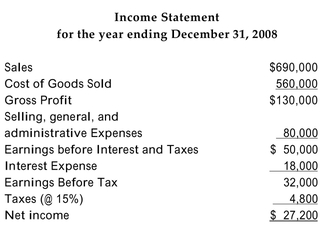
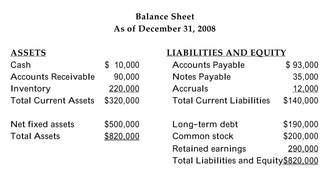 The firm has 100,000 shares of common stock outstanding with a market value of $8 a share.
The firm has 100,000 shares of common stock outstanding with a market value of $8 a share.
Refer to the information above. Calculate the enterprise value for Carmela's, assuming that the market value of its debt is equal to its book value.
A)$1,015,000
B)$1,120,000
C)$980,000
D)$670,000

 The firm has 100,000 shares of common stock outstanding with a market value of $8 a share.
The firm has 100,000 shares of common stock outstanding with a market value of $8 a share.Refer to the information above. Calculate the enterprise value for Carmela's, assuming that the market value of its debt is equal to its book value.
A)$1,015,000
B)$1,120,000
C)$980,000
D)$670,000
$1,015,000
3
The liabilities-to-equity ratio for a firm is 0.8, or 80%. What is its total liabilities-to-total assets ratio? Round your answer to the nearest tenth of a percent.
A)55.6%
B)44.4%
C)20.0%
D)125.0%
A)55.6%
B)44.4%
C)20.0%
D)125.0%
44.4%
4
The 2008 financial statements for Carmela's Catering are as follows: 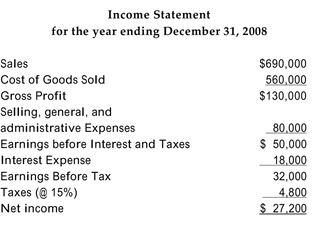
 The firm has 100,000 shares of common stock outstanding with a market value of $8 a share.
The firm has 100,000 shares of common stock outstanding with a market value of $8 a share.
Refer to the information above. Calculate the total liabilities-to-total assets ratio, based on book values, for the firm. Round your answer to the nearest tenth of a percent.
A)40.2%
B)38.8%
C)23.2%
D)none of the above

 The firm has 100,000 shares of common stock outstanding with a market value of $8 a share.
The firm has 100,000 shares of common stock outstanding with a market value of $8 a share.Refer to the information above. Calculate the total liabilities-to-total assets ratio, based on book values, for the firm. Round your answer to the nearest tenth of a percent.
A)40.2%
B)38.8%
C)23.2%
D)none of the above

Unlock Deck
Unlock for access to all 60 flashcards in this deck.
Unlock Deck
k this deck
5
The 2008 financial statements for Carmela's Catering are as follows: 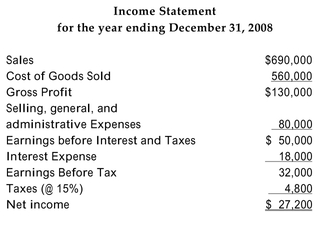
 The firm has 100,000 shares of common stock outstanding with a market value of $8 a share.
The firm has 100,000 shares of common stock outstanding with a market value of $8 a share.
Refer to the information above. The cost of Carmela's debt capital is 8%. The market beta of the firm's equity is 1.4. The relevant risk-free rate is 4% and the expected return on the market
Portfolio is 10%. Calculate Carmela's weighted average cost of capital.
A)11.4%
B)9.0%
C)12.4%
D)15.8%

 The firm has 100,000 shares of common stock outstanding with a market value of $8 a share.
The firm has 100,000 shares of common stock outstanding with a market value of $8 a share.Refer to the information above. The cost of Carmela's debt capital is 8%. The market beta of the firm's equity is 1.4. The relevant risk-free rate is 4% and the expected return on the market
Portfolio is 10%. Calculate Carmela's weighted average cost of capital.
A)11.4%
B)9.0%
C)12.4%
D)15.8%

Unlock Deck
Unlock for access to all 60 flashcards in this deck.
Unlock Deck
k this deck
6
The 2008 financial statements for Carmela's Catering are as follows: 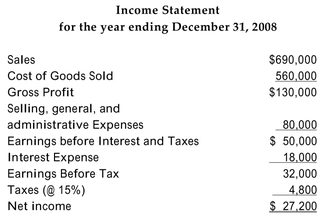
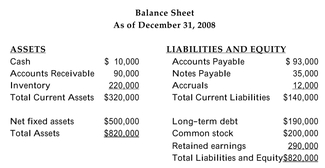 The firm has 100,000 shares of common stock outstanding with a market value of $8 a share.
The firm has 100,000 shares of common stock outstanding with a market value of $8 a share.
Refer to the information above. Calculate Carmela's interest coverage ratio.
A)1.78
B)1.51
C)2.78
D)7.22

 The firm has 100,000 shares of common stock outstanding with a market value of $8 a share.
The firm has 100,000 shares of common stock outstanding with a market value of $8 a share.Refer to the information above. Calculate Carmela's interest coverage ratio.
A)1.78
B)1.51
C)2.78
D)7.22

Unlock Deck
Unlock for access to all 60 flashcards in this deck.
Unlock Deck
k this deck
7
The liabilities-to-equity ratio for a firm is 2.5, or 250%. What is its total liabilities-to-total assets ratio? Round your answer to the nearest tenth of a percent.
A)28.6%
B)71.4%
C)40.0%
D)none of the above
A)28.6%
B)71.4%
C)40.0%
D)none of the above

Unlock Deck
Unlock for access to all 60 flashcards in this deck.
Unlock Deck
k this deck
8
Which of the following will result in a decrease in a firm's financial debt-to-assets ratio?
A)A firm pays out dividends to its shareholders.
B)A firm buys equipment using a bank loan.
C)A firm repurchases some of its stock.
D)A firm buys inventory using trade credit.
A)A firm pays out dividends to its shareholders.
B)A firm buys equipment using a bank loan.
C)A firm repurchases some of its stock.
D)A firm buys inventory using trade credit.

Unlock Deck
Unlock for access to all 60 flashcards in this deck.
Unlock Deck
k this deck
9
An argument for using the book value of the equity when calculating leverage ratios is that
A)many of the bond covenants use ratios based on the book value of equity.
B)it is less variable than the market value of the equity.
C)it is a measure of the true economic value of a firm.
D)Both A and B are arguments supporting the use of the book value of the equity.
A)many of the bond covenants use ratios based on the book value of equity.
B)it is less variable than the market value of the equity.
C)it is a measure of the true economic value of a firm.
D)Both A and B are arguments supporting the use of the book value of the equity.

Unlock Deck
Unlock for access to all 60 flashcards in this deck.
Unlock Deck
k this deck
10
The 2008 financial statements for Carmela's Catering are as follows: 
 The firm has 100,000 shares of common stock outstanding with a market value of $8 a share.
The firm has 100,000 shares of common stock outstanding with a market value of $8 a share.
Refer to the information above. Calculate the liabilities-to-equity ratio, based on book values, for the firm. Round your answer to the nearest tenth of a percent.
A)67.3%
B)38.8%
C)165.0%
D)95.0%

 The firm has 100,000 shares of common stock outstanding with a market value of $8 a share.
The firm has 100,000 shares of common stock outstanding with a market value of $8 a share.Refer to the information above. Calculate the liabilities-to-equity ratio, based on book values, for the firm. Round your answer to the nearest tenth of a percent.
A)67.3%
B)38.8%
C)165.0%
D)95.0%

Unlock Deck
Unlock for access to all 60 flashcards in this deck.
Unlock Deck
k this deck
11
Which of the following would result in an increase in a firm's financial debt-to-capital ratio, all else
Equal?
A)A firm's stock price increases.
B)A firm increases its use of trade credit.
C)A firm buys some equipment, using a bank loan.
D)both A and C.
Equal?
A)A firm's stock price increases.
B)A firm increases its use of trade credit.
C)A firm buys some equipment, using a bank loan.
D)both A and C.

Unlock Deck
Unlock for access to all 60 flashcards in this deck.
Unlock Deck
k this deck
12
The 2008 financial statements for Carmela's Catering are as follows: 
 The firm has 100,000 shares of common stock outstanding with a market value of $8 a share.
The firm has 100,000 shares of common stock outstanding with a market value of $8 a share.
Refer to the information above. Calculate the liabilities-to-equity ratio, based on the market value of the equity, for the firm. Round your answer to the nearest tenth of a percent.
A)23.8%
B)30.3%
C)17.4%
D)41.3%

 The firm has 100,000 shares of common stock outstanding with a market value of $8 a share.
The firm has 100,000 shares of common stock outstanding with a market value of $8 a share.Refer to the information above. Calculate the liabilities-to-equity ratio, based on the market value of the equity, for the firm. Round your answer to the nearest tenth of a percent.
A)23.8%
B)30.3%
C)17.4%
D)41.3%

Unlock Deck
Unlock for access to all 60 flashcards in this deck.
Unlock Deck
k this deck
13
The 2008 financial statements for Carmela's Catering are as follows: 
 The firm has 100,000 shares of common stock outstanding with a market value of $8 a share.
The firm has 100,000 shares of common stock outstanding with a market value of $8 a share.
Refer to the information above. What is the financial debt-to-capital ratio, based on the book value of the equity? Round your answer to the nearest tenth of a percent.
A)27.9%
B)31.5%
C)52.9%
D)95.0%

 The firm has 100,000 shares of common stock outstanding with a market value of $8 a share.
The firm has 100,000 shares of common stock outstanding with a market value of $8 a share.Refer to the information above. What is the financial debt-to-capital ratio, based on the book value of the equity? Round your answer to the nearest tenth of a percent.
A)27.9%
B)31.5%
C)52.9%
D)95.0%

Unlock Deck
Unlock for access to all 60 flashcards in this deck.
Unlock Deck
k this deck
14
Which of the following accounts would be included in a financial debt-to-capital ratio calculation?
A)pension liabilities
B)accounts payable
C)taxes payable
D)retained earnings
A)pension liabilities
B)accounts payable
C)taxes payable
D)retained earnings

Unlock Deck
Unlock for access to all 60 flashcards in this deck.
Unlock Deck
k this deck
15
The 2008 financial statements for Carmela's Catering are as follows: 
 The firm has 100,000 shares of common stock outstanding with a market value of $8 a share.
The firm has 100,000 shares of common stock outstanding with a market value of $8 a share.
Refer to the information above. What is the financial debt-to-capital ratio, based on the market value of the equity? Round your answer to the nearest tenth of a percent.
A)22.0%
B)19.2%
C)23.8%
D)28.1%

 The firm has 100,000 shares of common stock outstanding with a market value of $8 a share.
The firm has 100,000 shares of common stock outstanding with a market value of $8 a share.Refer to the information above. What is the financial debt-to-capital ratio, based on the market value of the equity? Round your answer to the nearest tenth of a percent.
A)22.0%
B)19.2%
C)23.8%
D)28.1%

Unlock Deck
Unlock for access to all 60 flashcards in this deck.
Unlock Deck
k this deck
16
Which of the following statements is (are)true?
A)The financial debt-to-capital ratio is the appropriate ratio to use in the weights for the WACC formula.
B)The total liabilities-to-total assets ratio is the appropriate ratio to use in the weights for the WACC formula.
C)Non-financial liabilities do not have a cost and are, therefore, hard to include in calculating a firm's WACC.
D)Both A and B are true statements.
A)The financial debt-to-capital ratio is the appropriate ratio to use in the weights for the WACC formula.
B)The total liabilities-to-total assets ratio is the appropriate ratio to use in the weights for the WACC formula.
C)Non-financial liabilities do not have a cost and are, therefore, hard to include in calculating a firm's WACC.
D)Both A and B are true statements.

Unlock Deck
Unlock for access to all 60 flashcards in this deck.
Unlock Deck
k this deck
17
The interest coverage ratio
A)indicates how many times a firm's net income will cover its interest expense and any principal payments that are due.
B)indicates how many times a firm's operating profit will cover its interest expense and any principal payments that are due.
C)indicates how many times a firm's operating profit will cover its interest expense.
D)indicates how many times a firm's net income will cover its interest expense.
A)indicates how many times a firm's net income will cover its interest expense and any principal payments that are due.
B)indicates how many times a firm's operating profit will cover its interest expense and any principal payments that are due.
C)indicates how many times a firm's operating profit will cover its interest expense.
D)indicates how many times a firm's net income will cover its interest expense.

Unlock Deck
Unlock for access to all 60 flashcards in this deck.
Unlock Deck
k this deck
18
One difference between financial and non-financial liabilities is that
A)financial liabilities result from a direct monetary contribution of the investors, but non-financial claimants have typically made a non-monetary contribution to the firm.
B)financial liabilities have a mandated regular payment schedule, but non-financial liabilities have no set schedule.
C)the holders of a firm's financial liabilities can force a firm into bankruptcy for non-payment while the holders of non-financial liabilities cannot.
D)All of the above are differences between financial and non-financial liabilities.
A)financial liabilities result from a direct monetary contribution of the investors, but non-financial claimants have typically made a non-monetary contribution to the firm.
B)financial liabilities have a mandated regular payment schedule, but non-financial liabilities have no set schedule.
C)the holders of a firm's financial liabilities can force a firm into bankruptcy for non-payment while the holders of non-financial liabilities cannot.
D)All of the above are differences between financial and non-financial liabilities.

Unlock Deck
Unlock for access to all 60 flashcards in this deck.
Unlock Deck
k this deck
19
An argument for using the market value of the equity when calculating leverage ratios is that
A)it is more stable than the book value of the equity, which is easily manipulated.
B)the market value of the debt is typically used in these ratios, so to be consistent the market value of the equity should be used.
C)it is a measure of the economic value of a firm.
D)All of the above are reasons that the market value of the equity should be used.
A)it is more stable than the book value of the equity, which is easily manipulated.
B)the market value of the debt is typically used in these ratios, so to be consistent the market value of the equity should be used.
C)it is a measure of the economic value of a firm.
D)All of the above are reasons that the market value of the equity should be used.

Unlock Deck
Unlock for access to all 60 flashcards in this deck.
Unlock Deck
k this deck
20
Which of the following accounts would not be included in a financial debt-to-capital ratio calculation?
A)accounts payable
B)retained earnings
C)long-term debt
D)Neither B nor C would be included in the calculation.
A)accounts payable
B)retained earnings
C)long-term debt
D)Neither B nor C would be included in the calculation.

Unlock Deck
Unlock for access to all 60 flashcards in this deck.
Unlock Deck
k this deck
21
According to data collected in 2003, larger publicly traded firms tended to
A)use more non-financial debt financing.
B)be more indebted than smaller firms.
C)have a ratio of short-term debt to total debt of about 50%.
D)all of the above.
A)use more non-financial debt financing.
B)be more indebted than smaller firms.
C)have a ratio of short-term debt to total debt of about 50%.
D)all of the above.

Unlock Deck
Unlock for access to all 60 flashcards in this deck.
Unlock Deck
k this deck
22
What are the two most important mechanisms that explain capital structure changes
over 5-year time horizons for U.S. firms? How much of the change in the debt-equity
ratios did these two factors explain?
over 5-year time horizons for U.S. firms? How much of the change in the debt-equity
ratios did these two factors explain?

Unlock Deck
Unlock for access to all 60 flashcards in this deck.
Unlock Deck
k this deck
23
According to data collected on the capital structure of firms in 2005, which of the following categories of firms would you expect to have the lowest debt-equity ratio?
A)airlines
B)computer software manufacturers
C)automobile manufacturers
D)mortgage bankers
A)airlines
B)computer software manufacturers
C)automobile manufacturers
D)mortgage bankers

Unlock Deck
Unlock for access to all 60 flashcards in this deck.
Unlock Deck
k this deck
24
Based on a study of capital structure changes over 5-year time horizons for publicly traded U.S. firms from 1964 to 2003,
A)net debt issuing activity and net equity issuing activity were equally important in effecting capital structure changes.
B)net long-term debt issuing activity was the most important mechanism through which a firm's capital structure changed.
C)net equity issuing activity was the most important mechanism through which a firm's capital structure changed.
D)net debt issuing activity and stock value changes were equally important in effecting capital structure changes.
A)net debt issuing activity and net equity issuing activity were equally important in effecting capital structure changes.
B)net long-term debt issuing activity was the most important mechanism through which a firm's capital structure changed.
C)net equity issuing activity was the most important mechanism through which a firm's capital structure changed.
D)net debt issuing activity and stock value changes were equally important in effecting capital structure changes.

Unlock Deck
Unlock for access to all 60 flashcards in this deck.
Unlock Deck
k this deck
25
Indicate how each of the following actions will affect the ratios provided, all else equal.
Use "+" for increase, "-" for decrease, and "0" for no change.
Use "+" for increase, "-" for decrease, and "0" for no change.


Unlock Deck
Unlock for access to all 60 flashcards in this deck.
Unlock Deck
k this deck
26
How does the capital structure of utilities differ from those of biotech companies?
What is the likely reason for this difference?
What is the likely reason for this difference?

Unlock Deck
Unlock for access to all 60 flashcards in this deck.
Unlock Deck
k this deck
27
According to a 1991 study of the capital structure of large firms throughout the world,
A)Germany had the highest indebtedness ratios of all the countries being studied.
B)Firms in the U.S., the U.K., and Canada tended to use more financial debt than the firms in other countries being studied.
C)U.S. corporations tended to have higher debt ratios than firms in other countries.
D)Firms in the U.S., the U.K., and Canada tended to have lower debt ratios than the other four countries being studied.
A)Germany had the highest indebtedness ratios of all the countries being studied.
B)Firms in the U.S., the U.K., and Canada tended to use more financial debt than the firms in other countries being studied.
C)U.S. corporations tended to have higher debt ratios than firms in other countries.
D)Firms in the U.S., the U.K., and Canada tended to have lower debt ratios than the other four countries being studied.

Unlock Deck
Unlock for access to all 60 flashcards in this deck.
Unlock Deck
k this deck
28
Firms tend to retire debt when
A)their stock price is deteriorating.
B)their debt ratio exceeds that of their peers.
C)interest rates have increased above previous levels.
D)all of the above.
A)their stock price is deteriorating.
B)their debt ratio exceeds that of their peers.
C)interest rates have increased above previous levels.
D)all of the above.

Unlock Deck
Unlock for access to all 60 flashcards in this deck.
Unlock Deck
k this deck
29
According to the empirical evidence, which of the following statements about capital structure is true?
A)Most firms tend to target a capital structure that is 40% debt and 60% equity.
B)Most of the changes in capital structure is the result of an attempt to time the market by management.
C)Slightly less than half of the changes in the capital structures of publicly traded, U.S. firms can be explained by changes in the value of their stock.
D)Managers typically target an optimal capital structure and react relatively quickly to adjust their firm's capital structure if market forces change it.
A)Most firms tend to target a capital structure that is 40% debt and 60% equity.
B)Most of the changes in capital structure is the result of an attempt to time the market by management.
C)Slightly less than half of the changes in the capital structures of publicly traded, U.S. firms can be explained by changes in the value of their stock.
D)Managers typically target an optimal capital structure and react relatively quickly to adjust their firm's capital structure if market forces change it.

Unlock Deck
Unlock for access to all 60 flashcards in this deck.
Unlock Deck
k this deck
30
From 1999 to 2001, most of the increase in equity shares outstanding were the result of
A)the exercise of convertible bonds and warrants.
B)mergers and acquisitions.
C)the exercise of executive stock options.
D)seasoned equity offerings.
A)the exercise of convertible bonds and warrants.
B)mergers and acquisitions.
C)the exercise of executive stock options.
D)seasoned equity offerings.

Unlock Deck
Unlock for access to all 60 flashcards in this deck.
Unlock Deck
k this deck
31
All else equal, which of the following would cause a decrease in the debt-equity (based on market value)ratio?
A)A firm repurchases some of its shares.
B)Dividends are paid.
C)The stock price increases.
D)All of the above will result in a decrease in the debt-equity ratio, all else equal.
A)A firm repurchases some of its shares.
B)Dividends are paid.
C)The stock price increases.
D)All of the above will result in a decrease in the debt-equity ratio, all else equal.

Unlock Deck
Unlock for access to all 60 flashcards in this deck.
Unlock Deck
k this deck
32
Empirical evidence suggests that when a firm's stock price increases, firms tend to
A)issue debt.
B)pay out more in dividends.
C)issue equity.
D)all of the above.
A)issue debt.
B)pay out more in dividends.
C)issue equity.
D)all of the above.

Unlock Deck
Unlock for access to all 60 flashcards in this deck.
Unlock Deck
k this deck
33
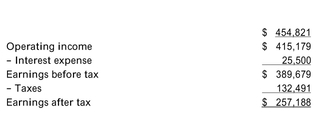
 There are 1 million shares outstanding with a current market value of $2 a share.
There are 1 million shares outstanding with a current market value of $2 a share.Refer to the information above. Calculate the following ratios for Serendipity Imports:
Total liabilities-to-assets, based on book value, financial debt-to-capital, based on
book value, financial debt-to-capital, based on market value, and the interest coverage
ratio.

Unlock Deck
Unlock for access to all 60 flashcards in this deck.
Unlock Deck
k this deck
34
What are the arguments for and against including non-financial liabilities when
calculating financial leverage ratios?
calculating financial leverage ratios?

Unlock Deck
Unlock for access to all 60 flashcards in this deck.
Unlock Deck
k this deck
35
Based on the empirical evidence, how do large firms and small firms differ in terms of
their use of debt?
their use of debt?

Unlock Deck
Unlock for access to all 60 flashcards in this deck.
Unlock Deck
k this deck
36
Which of the following statements is (are)true, based on data collected on the capital structure of publicly traded U.S. firms in 2003?
A)The average total indebtedness ratio was higher when book values were used instead of market values.
B)Less profitable firms tended to be more indebted.
C)Smaller firms tended to be more indebted than larger firms.
D)All of the above statements are true.
A)The average total indebtedness ratio was higher when book values were used instead of market values.
B)Less profitable firms tended to be more indebted.
C)Smaller firms tended to be more indebted than larger firms.
D)All of the above statements are true.

Unlock Deck
Unlock for access to all 60 flashcards in this deck.
Unlock Deck
k this deck
37
A $500 million firm has 10 million shares outstanding. The market price per share is
$30. What is its current debt-equity ratio? What will its debt-equity ratio be if the
market price per share drops to $20, all else equal?
$30. What is its current debt-equity ratio? What will its debt-equity ratio be if the
market price per share drops to $20, all else equal?

Unlock Deck
Unlock for access to all 60 flashcards in this deck.
Unlock Deck
k this deck
38
According to data collected in 2003, how much of smaller, publicly traded firms' debt was short-term?
A)25%
B)10%
C)67%
D)50%
A)25%
B)10%
C)67%
D)50%

Unlock Deck
Unlock for access to all 60 flashcards in this deck.
Unlock Deck
k this deck
39
Which of the following characteristics is likely to be associated with higher levels of indebtedness?
A)smaller firm size
B)fewer tangible assets
C)higher profitability
D)all of the above
A)smaller firm size
B)fewer tangible assets
C)higher profitability
D)all of the above

Unlock Deck
Unlock for access to all 60 flashcards in this deck.
Unlock Deck
k this deck
40
Rank the following in order of their importance (from most important to least important)in explaining capital structure changes over 5-year time horizons for publicly traded U.S. firms
From 1964 to 2003:
I. Net short-term debt issuing activity
II. Net long-term debt issuing activity
III. Dividend payments
IV. Net equity issuing activity
A)IV, II, I, III
B)II, IV, I, III
C)II, I, IV, III
D)IV, III, II, I
From 1964 to 2003:
I. Net short-term debt issuing activity
II. Net long-term debt issuing activity
III. Dividend payments
IV. Net equity issuing activity
A)IV, II, I, III
B)II, IV, I, III
C)II, I, IV, III
D)IV, III, II, I

Unlock Deck
Unlock for access to all 60 flashcards in this deck.
Unlock Deck
k this deck
41
Which of the following would you expect to have a low debt ratio, all else equal?
A)a firm with high accounting profits and tangible assets
B)a firm with a rating of BBB+.
C)a firm with a poorly performing stock
D)a firm with an AAA credit rating
A)a firm with high accounting profits and tangible assets
B)a firm with a rating of BBB+.
C)a firm with a poorly performing stock
D)a firm with an AAA credit rating

Unlock Deck
Unlock for access to all 60 flashcards in this deck.
Unlock Deck
k this deck
42
Which of the following statements regarding a firm's choice of financing is false?
A)Firms with higher marginal tax rates are more likely to issue debt than equity.
B)Firms with greater profitability are more likely to issue debt than equity.
C)Firms with more tangible assets are likely to use more debt in their capital structures.
D)Firms with fewer intangible assets are likely to use less debt in their capital structures.
A)Firms with higher marginal tax rates are more likely to issue debt than equity.
B)Firms with greater profitability are more likely to issue debt than equity.
C)Firms with more tangible assets are likely to use more debt in their capital structures.
D)Firms with fewer intangible assets are likely to use less debt in their capital structures.

Unlock Deck
Unlock for access to all 60 flashcards in this deck.
Unlock Deck
k this deck
43
Which of the following factors do not seem to matter in the choice of a capital structure?
A)the capital structure of a firm's peers
B)pecking order concerns
C)agency concerns
D)All of the above factors seem to matter in the choice of a capital structure.
A)the capital structure of a firm's peers
B)pecking order concerns
C)agency concerns
D)All of the above factors seem to matter in the choice of a capital structure.

Unlock Deck
Unlock for access to all 60 flashcards in this deck.
Unlock Deck
k this deck
44
According to survey results, which of the following seems to be a common belief held by CFOs?
A)It is best to repurchase shares when the stock price has increased in value in order to maintain the firm's capital structure.
B)Earnings dilution isn't an important issue because the funds generated with a new equity issue will be used to increase earnings per share.
C)Dividends are more attractive to tax-exempt institutional investors than they are to individual retail investors.
D)It is possible to forecast market interest rates accurately enough to be able to issue debt when interest rates are somewhere near their lowest levels.
A)It is best to repurchase shares when the stock price has increased in value in order to maintain the firm's capital structure.
B)Earnings dilution isn't an important issue because the funds generated with a new equity issue will be used to increase earnings per share.
C)Dividends are more attractive to tax-exempt institutional investors than they are to individual retail investors.
D)It is possible to forecast market interest rates accurately enough to be able to issue debt when interest rates are somewhere near their lowest levels.

Unlock Deck
Unlock for access to all 60 flashcards in this deck.
Unlock Deck
k this deck
45
According to survey results, what percentage of managers believe that their stock is undervalued by the market?
A)67%
B)88%
C)50%
D)33%
A)67%
B)88%
C)50%
D)33%

Unlock Deck
Unlock for access to all 60 flashcards in this deck.
Unlock Deck
k this deck
46
The desire of managers of large corporations for a lot of financial flexibility is usually
A)due to a desire to avoid financial distress.
B)value-enhancing for the firm's shareholders.
C)due to the freecash flow agency problem.
D)both A and C.
A)due to a desire to avoid financial distress.
B)value-enhancing for the firm's shareholders.
C)due to the freecash flow agency problem.
D)both A and C.

Unlock Deck
Unlock for access to all 60 flashcards in this deck.
Unlock Deck
k this deck
47
Which of the following do CFOs seem to be most concerned about when making capital structure decisions?
A)personal income taxes of their shareholders
B)credit ratings of their firm
C)transaction costs
D)corporate tax benefits associated with debt
A)personal income taxes of their shareholders
B)credit ratings of their firm
C)transaction costs
D)corporate tax benefits associated with debt

Unlock Deck
Unlock for access to all 60 flashcards in this deck.
Unlock Deck
k this deck
48
How might the desire by managers to have a lot of financial flexibility be more
self-serving than in the interest of the firm's shareholders?
self-serving than in the interest of the firm's shareholders?

Unlock Deck
Unlock for access to all 60 flashcards in this deck.
Unlock Deck
k this deck
49
What general firm characteristics tend to cause a firm to use more equity financing?

Unlock Deck
Unlock for access to all 60 flashcards in this deck.
Unlock Deck
k this deck
50
A CFO may end up undertaking negative NPV projects if he has
A)overestimated the expropriation concerns of the firm's creditors when estimating his firm's WACC.
B)ignored the inside information concerns of investors.
C)underestimated transaction costs when calculating his firm's WACC.
D)both B and C.
A)overestimated the expropriation concerns of the firm's creditors when estimating his firm's WACC.
B)ignored the inside information concerns of investors.
C)underestimated transaction costs when calculating his firm's WACC.
D)both B and C.

Unlock Deck
Unlock for access to all 60 flashcards in this deck.
Unlock Deck
k this deck
51
Firms tend to issue new equity rather than new debt if
A)their stock returns are positive.
B)their accounting financial statements present a positive picture.
C)they have high tax obligations.
D)all of the above.
A)their stock returns are positive.
B)their accounting financial statements present a positive picture.
C)they have high tax obligations.
D)all of the above.

Unlock Deck
Unlock for access to all 60 flashcards in this deck.
Unlock Deck
k this deck
52
If a CFO wants to maintain a targeted capital structure, she should
A)repurchase shares when the firm's stock price has increased considerably.
B)issue more equity when the firm's stock price has increased considerably.
C)issue more debt whenever interest rates fall, and retire debt when interest rates rise.
D)both A and B.
A)repurchase shares when the firm's stock price has increased considerably.
B)issue more equity when the firm's stock price has increased considerably.
C)issue more debt whenever interest rates fall, and retire debt when interest rates rise.
D)both A and B.

Unlock Deck
Unlock for access to all 60 flashcards in this deck.
Unlock Deck
k this deck
53
A CFO will underestimate his firm's cost of capital if he
A)overestimates the personal tax rates faced by the firm's investors.
B)underestimates transaction costs.
C)ignores the implications of excess free cash flow.
D)both B and C.
A)overestimates the personal tax rates faced by the firm's investors.
B)underestimates transaction costs.
C)ignores the implications of excess free cash flow.
D)both B and C.

Unlock Deck
Unlock for access to all 60 flashcards in this deck.
Unlock Deck
k this deck
54
Which of the following statements about debt ratios is (are)supported by the empirical evidence?
A)Firms with high accounting profits and more tangible assets tend to have lower debt ratios, all else equal.
B)Firms with high corporate income tax rates tend to issue more debt, but often have relatively low debt ratios.
C)Firms that generate higher stock returns use more debt and have higher debt ratios.
D)Both A and B are supported by the empirical evidence.
A)Firms with high accounting profits and more tangible assets tend to have lower debt ratios, all else equal.
B)Firms with high corporate income tax rates tend to issue more debt, but often have relatively low debt ratios.
C)Firms that generate higher stock returns use more debt and have higher debt ratios.
D)Both A and B are supported by the empirical evidence.

Unlock Deck
Unlock for access to all 60 flashcards in this deck.
Unlock Deck
k this deck
55
What are some tax issues that might explain why firms in the same industry tend to
have the same capital structure?
have the same capital structure?

Unlock Deck
Unlock for access to all 60 flashcards in this deck.
Unlock Deck
k this deck
56
CFOs are more likely to issue new shares of equity when
A)their firm's stock price is relatively high.
B)the market interest rates are high.
C)their firm's stock price is relatively low.
D)both B and C.
A)their firm's stock price is relatively high.
B)the market interest rates are high.
C)their firm's stock price is relatively low.
D)both B and C.

Unlock Deck
Unlock for access to all 60 flashcards in this deck.
Unlock Deck
k this deck
57
A CFO may neglect to undertake good projects if he has
A)overestimated transaction costs when estimating his firm's WACC.
B)failed to account for the expropriation concerns of the firm's creditors when estimating his firm's WACC.
C)underestimated the personal tax rates faced by the firm's investors when estimating his firm's WACC.
D)both A and C.
A)overestimated transaction costs when estimating his firm's WACC.
B)failed to account for the expropriation concerns of the firm's creditors when estimating his firm's WACC.
C)underestimated the personal tax rates faced by the firm's investors when estimating his firm's WACC.
D)both A and C.

Unlock Deck
Unlock for access to all 60 flashcards in this deck.
Unlock Deck
k this deck
58
Which of the following is a lesson gleaned from the empirical evidence that a CFO might find useful in determining his own firm's capital structure?
A)CFOs should simply copy the capital structure of their firm's peers since the optimal capital structure seems to be the same for firms within the same industry.
B)The failure to rebalance his firm's capital structure when market forces change it is the sign of a bad manager.
C)The decision whether to rebalance a firm's capital structure, if necessary, when market forces change it should be based on a cost-benefit analysis.
D)Capital structure is irrelevant,which is why smart CFOs do not bother to rebalance their firm's capital structure when market forces change it.
A)CFOs should simply copy the capital structure of their firm's peers since the optimal capital structure seems to be the same for firms within the same industry.
B)The failure to rebalance his firm's capital structure when market forces change it is the sign of a bad manager.
C)The decision whether to rebalance a firm's capital structure, if necessary, when market forces change it should be based on a cost-benefit analysis.
D)Capital structure is irrelevant,which is why smart CFOs do not bother to rebalance their firm's capital structure when market forces change it.

Unlock Deck
Unlock for access to all 60 flashcards in this deck.
Unlock Deck
k this deck
59
If tax laws were to change such that corporate tax rates increase while personal tax rates are unchanged, which of the following would you expect to happen, all else equal?
A)Firms will retire more of their debt.
B)Firms will use more equity financing.
C)Firms will finance their operations more with retained earnings (internal equity financing).
D)Firms will use more debt financing.
A)Firms will retire more of their debt.
B)Firms will use more equity financing.
C)Firms will finance their operations more with retained earnings (internal equity financing).
D)Firms will use more debt financing.

Unlock Deck
Unlock for access to all 60 flashcards in this deck.
Unlock Deck
k this deck
60
Which of the following statements about the choice of a capital structure is (are)true?
A)Firms seem to like to have a capital structure that is similar to that of their peers.
B)Firms with more volatile underlying assets use more debt financing.
C)Firms with lower corporate tax rates tend to issue more debt than those with higher corporate tax rates.
D)Both B and C are true statements.
A)Firms seem to like to have a capital structure that is similar to that of their peers.
B)Firms with more volatile underlying assets use more debt financing.
C)Firms with lower corporate tax rates tend to issue more debt than those with higher corporate tax rates.
D)Both B and C are true statements.

Unlock Deck
Unlock for access to all 60 flashcards in this deck.
Unlock Deck
k this deck



